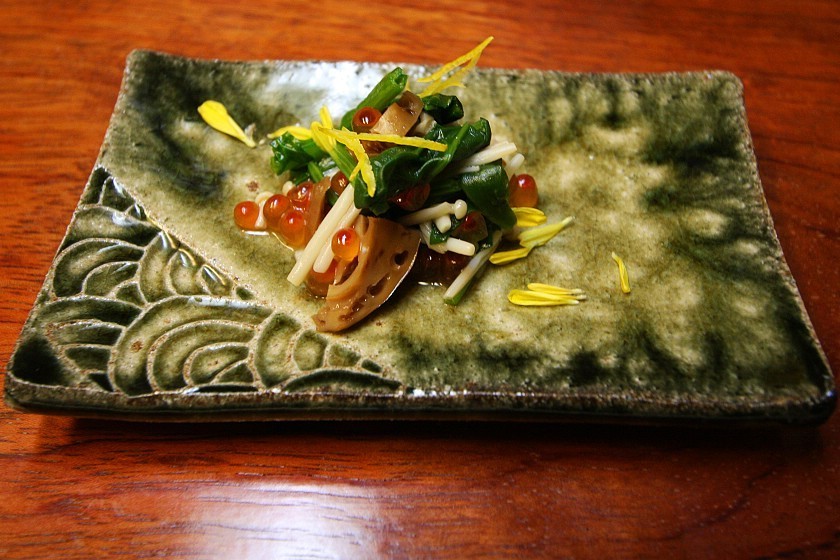Kansai Cuisine

As the two major cultural and political centres in Japanese history, the areas of Kanto and Kansai have not only developed vibrant cultural identities entirely of their own, but seem to especially enjoy doing things differently to one another - and this is especially true of the two regions' cuisines. While Tokyo has the distinction of more Michelin stars than any other city in the world, Kansai is home to an especially rich and varied culinary tradition, earning it a reputation as the "kitchen of Japan". If you're a foodie planning your own gastronomic adventure in Japan, here are five unmissable dishes to try in the Kansai area:
Takoyaki
A classic street food strongly associated with Osaka, takoyaki are fried balls of gooey wheat batter containing octopus, green onions and tempura scraps, brushed with a sweet, tangy sauce and topped with dried bonito flakes. Stalls or yatai selling takoyaki are a common sight at summer festivals and around the Dotonbori area of downtown Osaka.
Regularly featured in magazines and on TV travel shows, Kougaryu in the Amerikamura area is perhaps the best-known takoyaki restaurant today. Purists may prefer Aizuya near Osaka Station, the oldest shop in the country where the takoyaki are served without any of the usual condiments.

Okonomiyaki
Combining the word "fry" with the phrase "as you like it", Okonomiyaki refers to another signature Osakan dish made with dense, pan fried batter, shredded cabbage and other ingredients ranging from meat or seafood to cheese. Like takoyaki, it usually comes with a topping of sweet, sticky sauce and bonito flakes, and is a perfect comfort food - delicious, filling and unpretentious.
Although okonomiyaki restaurants are a common sight, two great places to try are Kiji, a cosy hole-in-the-wall near Osaka Station with a cosy, retro atmosphere, and Mizuno near Dotonbori, which boasts a Michelin star and is one of just a handful of spots offering vegetarian and gluten-free options.

Udon
A popular favorite throughout Japan, these thick noodles made from wheat flour are every bit as beloved in the Kansai region as they are in Kanto albeit with a few key differences. Where udon in Kanto tend to be served in a stronger-tasting soup of bonito-infused dashi and dark colored soy sauce, in Kansai the soup is traditionally lighter in color and flavor, made with kombu (seaweed) dashi and a thinner, saltier soy sauce.
One of the best-known udon restaurants in Osaka, Imai is a great mid-range option and offers a peaceful retreat from the crowded Dotonbori area. In Kyoto, two terrific options are Yamamoto Menzo, famous for udon served with deep fried mochi, and Okakita, known for delicate udon made with sesame. The two restaurants are located side by side close to the Heian Shrine, so you visit whichever has the shortest line!

Kobe Beef
While a larger part of the Kanto area was historically set aside for raising horses, Kansai became known as one of Japan's cattle country and for this reason places a greater emphasis on beef in its cuisine. One of the best known and most sought after types in the world, Kobe beef comes from the black Tajima breed of wagyu cattle found in Hyogo Prefecture and has to satisfy a strict set of requirements before it can be considered the genuine article, with high levels of fat marbling creating a buttery-smooth texture.
Two excellent teppan yaki options are Kokubu near Kobe's Sannomiya Station, with English-speaking staff and prices starting from around 10,000 yen, and the Michelin-starred Itoh Dining in Kyoto, with prices starting at 3,500 yen for lunch and 5,000 yen for dinner courses. Another delicious way to enjoy kobe beef is sukiyaki, where meat and vegetables are simmered together in a hot pot with sugar, soy sauce and mirin and dipped in raw egg. Kitamura, near Osaka's Shinsaibashi Station, makes delicious kobe beef sukiyaki in the Kansai style - adding more sugar to the sauce to caramelise and soften the meat.

Kaiseki and Kappo
A carefully curated course meal with roots in Zen Buddhism and intimately connected with the passing of the seasons, kaiseki is considered the pinnacle of Japanese haute cuisine and strongly associated with Kyoto. Often described as a transcendent experience, true kaiseki can also be an intimidating one, not least because of the price involved. Two Michelin starred but still aproachable and relatively reasonably priced options are Kappo Sakamoto (lunches from 5,000 yen and dinners from 16,000 yen) and Kiyamachi Sakuragawa (lunches from 7,000 yen and dinners from 20,000 yen).
A close relative of kaiseki, shojin ryori is a sophisticated style of vegetarian cuisine originating in Buddhist temples and monastaries. Located within the beautiful grounds of Tenryuji in Arashiyama, Shigetsu (courses from 3,300 yen) is the perfect place to try this style of cuisine as part of a day's sightseeing.






